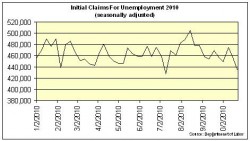 Initial claims for unemployment dropped last week, surprising economists who had expected to see a modest increase. Instead, the U.S. Department of Labor reported that first filings declined 21,000 to a seasonally adjusted 434,000. It was the second decline in two weeks and brings the number of initial claims to the lowest point since July.
Initial claims for unemployment dropped last week, surprising economists who had expected to see a modest increase. Instead, the U.S. Department of Labor reported that first filings declined 21,000 to a seasonally adjusted 434,000. It was the second decline in two weeks and brings the number of initial claims to the lowest point since July.
A Bloomberg survey before this morning’s release found economists expecting initial claims would rise an average of 3,000. The Department of Labor did revise its preliminary number for the week ending Oct. 9 from 452,000 to 455,000. Even with the adjustment, October has seen a decrease of more than 15,000 in initial filings. The 4-week moving average, a way of smoothing out weekly bumps in the data due to holidays, weather, and other causes, was 453,250, a decrease of 5,500 from the previous week’s revised average of 458,750.
Next week (Nov. 5) the U.S. Bureau of Labor Statistics releases its initial employment survey for October. The closely-watched report details the current status of employed and unemployed workers in the U.S. based on surveys of businesses and residential households. Early predictions are that the unemployment rate will remain at 9.6 percent, while private sector jobs will grow in the range of 60,000 to 70,000.
In addition to the BLS data, investors and economists are also carefully watching the Federal Reserve board, which is scheduled to meet Nov. 3. It’s anticipated that the board will announce an asset purchase plan.